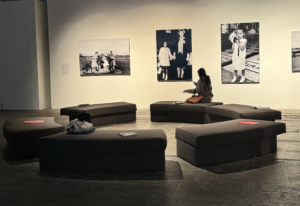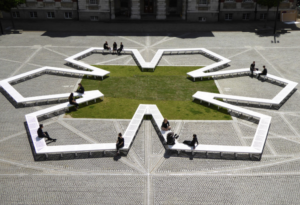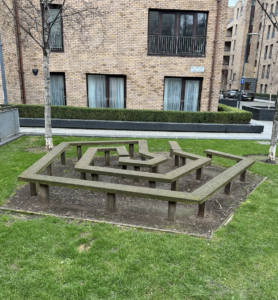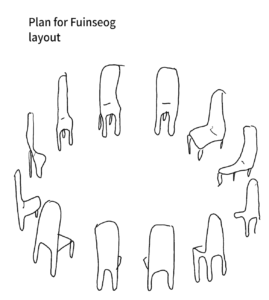Week 8
Claire Jackson’s talk at Tramway was fascinating as she spoke with such respect and adoration about Maud Sulter’s work which is currently being exhibited. What I found fascinating was the over and back that goes on between the curator and Sulter’s estate when it comes to the layout of the exhibition – this is something I have never really considered as I have often presumed that the final layout would be decided by the curator of the space. Jackson touched on the seating area placed at the right hand side of the exhibitions entrance. It consists of several benches placed in a circle. As the exhibition goes on for months at a time, Tramway is sure to diversify the space through hosting various events against the background of the exhibition. The circular seating area is used for poetry readings and talks, reminding me of the layout for my speculative project and leading me to consider the significance of conversation pits and seating designed to encourage communication.

Fran Cottell’s Pentagon Petal is a structure which can function as multiple conversation pits.

On my way home from the train station I happened upon this stricture which I have often seen young people use in the evenings as they smoke and drink with each other. This is another good example of how multiple conversations and meetings can happen at once upon the same structure.

I want to look further into the significance and design of seating area It could be an interesting addition to my installation of ash sculptures which also function as a conversational pit. Perhaps the design could be different, something continuous like the bench above or Cottell’s piece.



Pitch Feedback
Your peer feedback suggested blending the functionality of the Irish ash tree with its symbolic role in guardianship and drawing from indigenous knowledge was a clear and interesting subject. With references to artists like William Cronin and Fionn Timmins, it emphasises environmental awareness, including ash dieback fungus. The strong visual identity and clear use of quotes create an engaging experience with you PowerPoint. The online archive’s documentation, incorporating aural histories raises questions about traceability and transcription ethics. The work’s aesthetic promises a potentially compelling catalogue/visual identity.
Your curatorial pitch presents an intriguing and thoughtful concept, though further clarification on key aspects would strengthen the proposal. The title Fuinseog suggests a deep connection to place, memory, or mythology, but a clearer articulation of the exhibition’s central themes and theoretical framework would provide stronger context. How does this project contribute to contemporary curatorial discourse, and what key questions does it aim to explore? Having say that it is a very stroinga nd achievable concept.
The curatorial format and mediums should be more explicitly detailed. Are you proposing a physical exhibition, a digital platform, or a hybrid model? What role do artists or participants play in shaping the exhibition, and how does audience engagement factor into the experience? If interactive or site-specific elements are included, explaining their significance will enhance the proposal’s impact. You have started to address these points, but stating them more directly would make the proposal clearer and convey stronger intentions. Your aural presentation was really good and covered most of the points above; however, they are not articulated as clearly in your PowerPoint.
Finally, consider adding a dedicated slide that summarises your references and influences. This will link your project to existing curatorial practices or other curatorial theories you mentioned exploring. Please don’t underestimate the value of what you’ve researched, as I can only evaluate what you choose to include in your presentation. Overall, this is a promising concept that would benefit from greater specificity, but it is a strong and achievable idea. With the suggested improvements, you will create an excellent speculative project.
Blog Feedback
It is good to see you developing the use of your blog and including more visual examples. It is also good to see that you are using it as a space to show your current processes and thoughts on your projects and how you might improve them. It is clear that you are considering the ethical ramifications of your curatorial approach. This will strengthen your project and make you a better curator. You appear to be taking feedback well and researching the suggestions made by the group. This expands your contexts and provides evidence of a wide understanding of curatorial approaches.
It is great to see that you are engaging with the contemporary art world, as evidenced by your trip to Tramway to see Claire Jackson’s talk. It has given you useful insight into the process of exhibition-making and the importance of dialogue between the curator and the artists or the artist’s estate. It is also useful for your own project to see how circular seating can be used as a discursive space in an exhibition. Furthermore, it was great to see you do your own research into other examples of circular seating. I believe this will provide greater context and understanding when you develop your own use of circular seating and commissioning artists. An important question is: Can a curator expect an artist to make the work for them? How do you make space for the artist to adapt and stay true to their vision?
Your reflections on Claire Jackson’s talk at Tramway provide a compelling insight into the interplay between curators, estates, and exhibition layouts—something that is often overlooked. It’s particularly interesting that you challenge the assumption that curators have full autonomy over the final arrangement. The negotiation process you mention adds an important dimension to curatorial practice, highlighting how multiple stakeholders shape an exhibition.
Your observation of the circular seating area at the exhibition’s entrance is well-articulated, especially in how it ties into your speculative project. The fact that Tramway uses the space dynamically—for poetry readings and talks—emphasizes how seating arrangements influence engagement and interaction. Your connection to conversation pits is insightful, as it underscores how spatial design fosters communication.
Your reference to Fran Cottell’s Pentagon Petal adds another layer to this discussion. The idea of a modular, multi-functional structure that accommodates simultaneous conversations is particularly relevant to your project. It suggests that seating is not just functional but can be conceptually and socially significant, shaping the way people interact within an exhibition.
Your real-world observation—young people informally using a public structure for social gatherings—further reinforces this theme. It’s a reminder that seating is never neutral; it invites specific kinds of interactions, whether structured (as in Tramway) or organic (as in public spaces). This could be a valuable direction for your project—considering how design can encourage both formal discussions and informal, spontaneous interactions.
As you explore seating arrangements for your installation of ash sculptures, you might consider how form affects function. Should the seating be strictly circular to reflect Irish storytelling traditions? Or should it be more open-ended, like the continuous bench or Cottell’s Pentagon Petal, to encourage a broader range of interactions? Either way, your reflections suggest an exciting evolution of your project, making the seating itself part of the storytelling process.
Finally, I would like to say that your post is thoughtful and well-connected to both curatorial practice and your own project. I look forward to seeing how your exploration of seating design shapes the final concept of your installation!